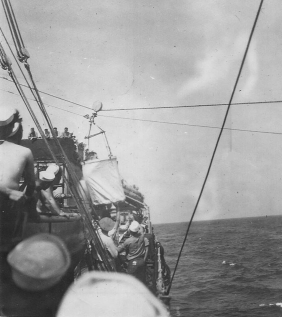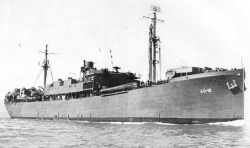The Breeches Buoy
Getting from One Ship to Another
Memoirs of the USS Denebola in WW2
By Stephen Sherman, April, 2010. Updated February 16, 2012.
This picture goes with the story of sending the radio technician to the minesweeper. Originally the story was incidental to the account of the Denny's (USS Denebola, AD-12) eastward crossing.
One of the minesweepers that was part of our convoy on the way back from the Mediterranean developed a problem with its radio gear that was beyond the capability of its own crew. Since we were a tender and servicing other ships (destroyers in particular) was our job, we sent a man over to help them out.
This arrangement, called "Breeches Buoy," was standard procedure for getting from one ship to another without a boat. Actually it is not a buoy at all, but is a system of ropes and pulleys between two ships. As can be seen here it is being used to transport a man.
It is also obvious that calm water is essential. However even though the surface is calm the operation does not always go well because of swells. The surface of the sea is always undulating. This creates the swells, which cause the two ships to roll. If both ships could be made to roll in sync, or parallel the work would be much easier. But ships don't like to do that. They like to roll in opposite directions just to make things difficult. And does it ever.
This is where the skill and coordination of the deck force men are put to the test. Keep in mind that this rig is attached to a suitably high point on each ship's mast in an effort to keep the "cargo" from getting dunked. That in turn, compounds the inherent problem, which is to keep the cargo out of the water. That is far from easy. As the men hold the "bitter" end (the bitter end is that portion of the lines that could be called extra length) of the lines they must run back and forth in sync with the rolling of the ships so as to keep the lines taut and thereby keep the cargo out of the water.
The deck force didn't do very well that day, but how they tried. It was a harrowing experience for the man in the canvas bag. He did get a slight dunking, and the deck force sweat bullets.
But it was a real circus for all of the spectators. There was much urging, cheering, and excitement. A day to remember! Life was seldom dull on the old Denny.
Sources:
Memoirs and photographs of Milton W. Sherman (1919-2010). He served in the U.S. Navy during WW2, on board the USS Denebola, AD-12, when he was in mid-twenties. On board the Denebola, he sailed to the Mediterranean in late 1944, when this event took place. You might enjoy reading a fuller version of his travels in the Denebola.


